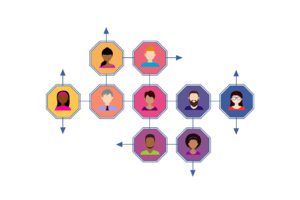While many companies feel that the key to successful advertising is getting the word out to as many people as possible, this isn’t exactly the case.
The truth is that by throwing your net too wide, you risk catching the attention of all kinds of people. This might sound great –but the reality is that most of them will not be anywhere near your target customer, and therefore will be highly unlikely to convert.
While broad advertising tactics may work if you’re selling a product that quite literally everyone on earth needs, the truth is that these type of companies are few and far between. Instead, most companies could benefit by employing a more targeted and tactical approach. Instead of casting a wide net, fly fishing may be a better approach.
Enter market segmentation –the practice of dividing up your market of potential customers into specific segments. The beauty of market segmentation is that it allows you to narrow in on the type of customers that’ll be most likely to buy your products, or subscribe to your message, allowing you to create an extremely tailored, and far more effective promotional strategy –enabling you to target them far more effectively

While market segmentation is an often-overlooked strategy, especially when it comes to B2B companies, the truth is that it’s one of the oldest marketing tricks in the books. Targeted advertising goes way back, and you can see examples from early in the last century, ranging from Jell-O placing targeted ads in Ladies’ Home Journal, to tire company Michelin developing the Michelin Guide; offering drivers information on topics like auto maintenance, hotels, and travel. In fact, you could even go back to 1885, when John Deere launched their farm-staple magazine, The Furrow.
But while this tactic is old, it’s certainly not outdated. And today, as the customer population and their preferences grows wider, and as new competitors continually arrive on the scene, it’s arguably more relevant now, than ever, to keep market segmentation in mind when creating your marketing strategy or even when launching new products.
In order to target potential customers, you’ll want to determine which type of customer your product will attract. Market segmentation is one of the best ways to ensure that you understand exactly who your customer is and what they want, giving you an excellent basis on which to create content that’s specifically designed to reach them.
Segmenting your customers like this will change the language that you use, the pain points that you touch upon, and ultimately their motivations for buying –which can be vastly different between groups.
When I first launched my webstore RTA Cabinet Store, I soon discovered that we had five very different customers –and each had a different reason for buying cabinets. Our five segments were homeowners, contractors, property investors, real estate agents, and property managers.
Of course, this was just a basic, broad-level assessment. Each of those segments was also able to be divided up even further, based on things like income level, and what their motivations were for buying. The result of going the extra mile and narrowing down our clients? We were able to tailor our marketing efforts to appeal to each different segment, and drastically improve our conversion rates.
In fact, we were able to increase lifetime value by over 60%, by segmenting customers into niche groups, and focusing on their specific needs.
Why Should You Have a Target Market?
But my story isn’t an isolated case; targeted marketing is a solid tactic that can work for anyone.
I mean, it makes sense when you think about it.

No one’s the same, we’re all after different things, and look for different features when we buy. Even for those of us who are after the same product –our reasons for buying could vary considerably. Think, for a second, about the very different approach than, say, a homeowner would take to buying cabinets compared to, say a house flipper.
Instead of creating one single product, and having one approach for your message, think of how much more effective you could be by tailoring your approach to meet everyone exactly where they’re at.
And many marketers are seeing value in this approach. According to Salesforce’s State of Marketing report, 60% of B2B marketers say that they’ve been more focused on improving audience segmentation and personas over the past 18 months. Additionally, some 52% of consumers are likely to switch brands if a company doesn’t make an effort to personalize its communications.
Target marketing matters –now, more than ever.
Not only does it allow you to reach your customers more effectively, it can also reduce marketing costs. This is because, instead of wasting time and money trying to please everyone, you’ll be able to reach the ones that matter –customers that are likely to convert, allowing you to improve your conversion rates and increase your sales.
According to Angela Hausman PhD with hausmanmarketingletter.com, it’s important to resist the temptation to be too general. Don’t think that going broad will give you access to a larger slice of the market. “That’s like firing 10 bullets in random directions instead of aiming just one dead center of the mark–” Hausman says, “expensive and dangerous.”
If you can segment your market down to just the right group of prospective customers, you’ll be able to gain the following advantages.
Take a look:
- Gain a better understanding of your group of buyers, allowing you to increase your chances of winning them over.
- Increase your ad, website copy, and email content’s effectiveness. As I mentioned earlier, knowing your customer allows you to create copy that’ll reach them far more effectively than you would with a broad, overtly salesy approach.
- Increase your testimonials’ and case studies’ effectiveness. If you’re able to provide testimonials, reviews, and case studies that touch on the same problems and solutions your target market is experiencing, you’ll be able to drastically increase their effectiveness.
- Eliminate competition. By being specific, you can help to beat out the completion that’s taking a broader, less targeted approach. Hone in on what, exactly, your prospects are looking for and you’ll be able to reach them better.
- Mass produce more easily. If you’re able to create a buyer persona that’s extremely targeted, you’ll be able to work to replicate, and even ultimately mass produce your product or service, lowering the time and effort required to replicate it, and increasing your bottom line.

Get our Market Segmentation Worksheet delivered right to your inbox.
Segmenting Your Market
So all of this begs the question: How do you get started segmenting your market?

Grant Leboff, author and sales and marketing expert has shared a list of six steps for defining your target market. Let’s look at them now:
Understand the Problem That You Solve
Start by getting clear on the problem that you’re solving.
Paint a Picture of the Customer
Next, list all the different types of customers that suffer from the problems that you solve. You can then start to build up a picture of these customers.
Determine Who Will Benefit Most
Ask yourself who is most likely to gain from the value you offer, or from the problem you solve. Once you can demonstrate that the cost of ignoring the issues is more than the cost of solving it, you’ll be on the right track.
Think About Your Market
We live in a world of niche, and it’s a far more effective strategy to be a big fish in a small pond rather than the other way around. Begin segmenting now. Which type of people do you want to work with? Particular types of people, people in certain geographical locations, etc.?
Look Internally at Your Company
One helpful way to determine which markets to pursue is by thinking about your company itself.Do you have any particular areas of expertise? Do you have specific knowledge of a certain geographical area? Concentrating on this marketplace could give you a foundation on which to build.
Investigate Competitors in This Market
Finally, you’ll want to look to see what else is available. Make sure you have an answer to the question, “Why am I uniquely placed to solve the problem?”
Another way to segment your market, is by paying close attention to four main variables; demographic variables (age, income, gender, etc.), geographic variables (country, urban vs. suburban, location, etc.), psychographic variables (attitudes, loyalty, values, etc.), and behavioral variables as well.
Here’s a look at all four now:
-
Demographic Segmentation
Segmenting by demographic is a simple and often-used form of market segmentation. Demographic segmentation generally includes factors such as age, gender, and income; but it can also include variables like family size, occupation, religion, race, and nationality. We see demographic segmentation in marketing all the time.
Take, for instance, the automobile market; that has different price brackets that vehicles are sold under. While Maruti has the low price bracket, Audi and BMW have the high price bracket and target high-end buyers. This is an example of segmenting by income, but there plenty of different ways that you can segment by demographic.
-
Behavioral Segmentation
Behavioral marketing segmentation studies the behaviors of people. It targets people based on their response to a specific product. This marketing is also used widely across the board, for instance, older people tend to shop for different products than younger people, and those who are marketing to the older generation would use the behavior segmentation to help influence their advertising.
While not everyone fits into the same behavioral pattern, generally, it can help you to tailor your marketing strategy.
-
Psychographic Segmentation
The psychographic segmentation is much like the behavioral segmentation, but it takes into account the psychological aspects of why people buy. It deals with the lifestyles of people, their activities, interests, and even opinions. These things, taken into consideration together can help to paint a picture of a customer’s lifestyle, allowing you to create products, or market them more effectively in order to appeal to a certain interest, lifestyle, or ideal.
-
Geographic Segmentation
Finally, geographic segmentation, as the name suggests, is targeting prospective customers based on their location. This is especially useful for brick and mortar businesses, or smaller companies who are targeting local clients.
Once you’ve got an idea about your target market, you can start creating groups that you can target with different messages and campaigns. You’ll also want to determine which group will be the most profitable; the one that you’ll want to primarily focus on. From there, you can work to create a strong message, and promote product features that will meet the needs of your target market in a way that’s far more tailored than anything that you’d be able to otherwise.
Asking the following questions will help you to create different groups:
- Are there some groups with different needs/wants?
- Are there groups who feel differently or think differently?
- Are there groups who have different lifestyles?
Not all markets will have different groups, but in most cases, they will. If you find that you have one distinct group only then you can concentrate your efforts on creating messaging for them, but in most cases, you’ll find that you have different groups that you can market to. Often, you can even market the same products to different groups; you’ll just need to tailor your approach.
When it comes to my cabinet business, for example, I target different groups with different messages, even though ultimately, the products that I sell are the same. Be sure to determine which of your products are a good fit for specific groups and then adjust your messaging and marketing strategies accordingly.
If you’re thinking of launching a new marketing initiative, or even a product, remember: In most cases, niche is always better. Fly fishing all the way! By understanding the different segmentations and working to separate your audience into groups, you’ll be able to tailor your marketing, advertising, and promotional efforts, fine-tune your strategy, and increase your chances of reaching the right group of customers.
How do you tailor your content or ads to reach a specific segment of customers?

Get our Market Segmentation Worksheet delivered right to your inbox.







